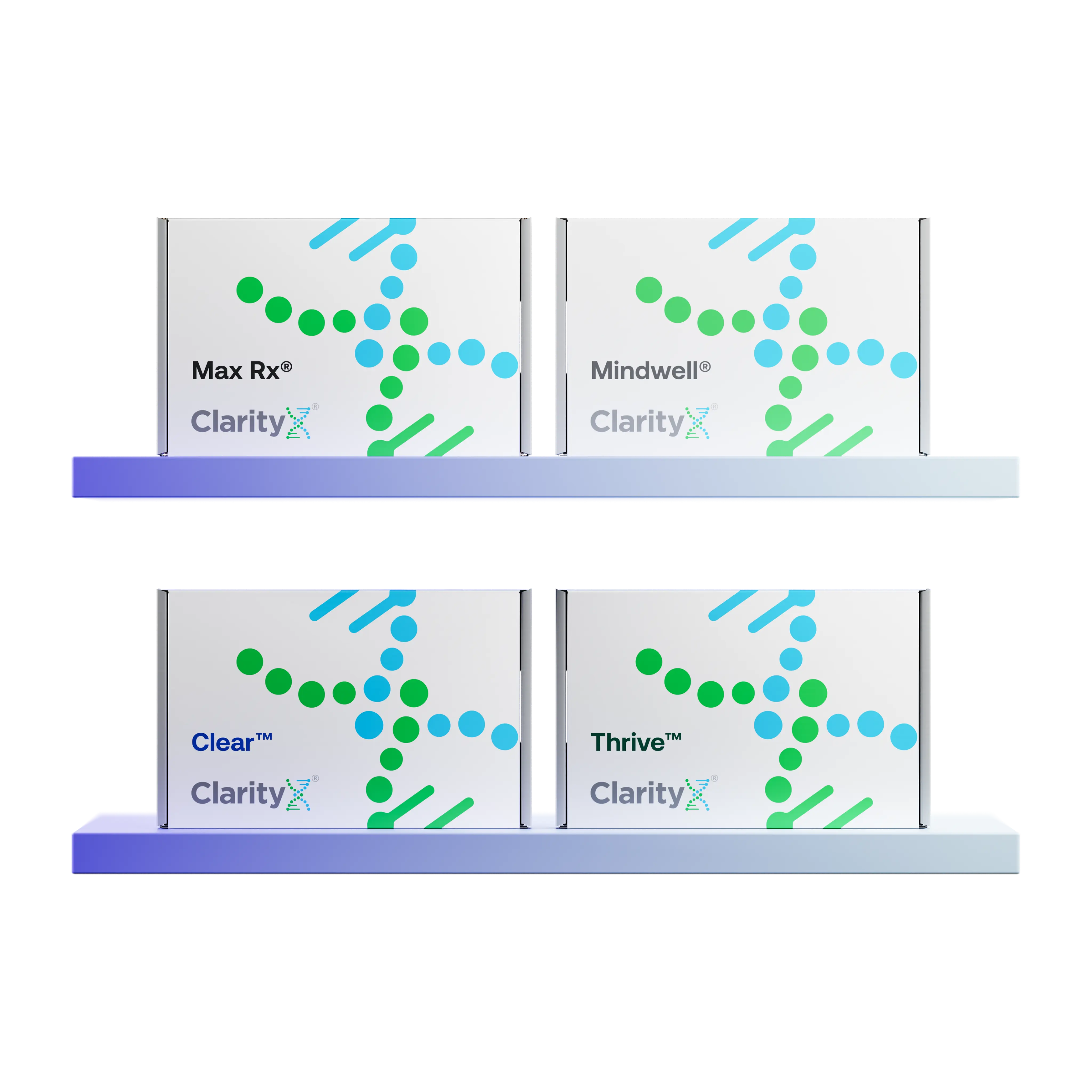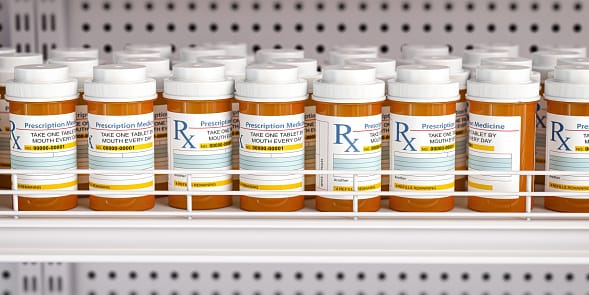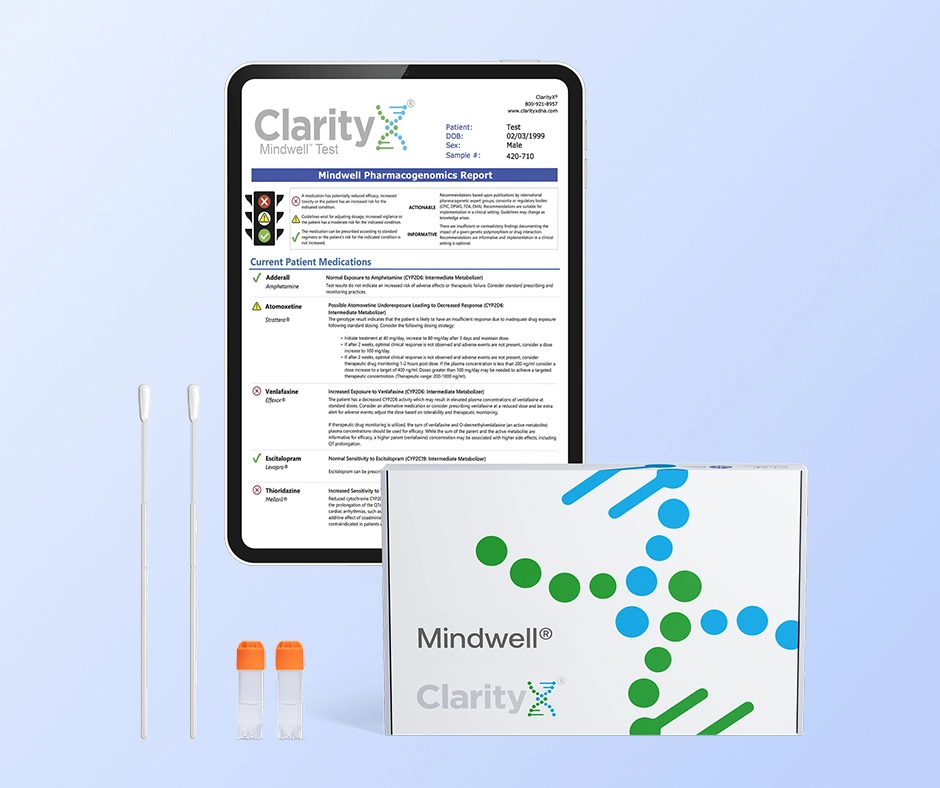Key Takeaways
- Both medications are selective serotonin reuptake inhibitors (SSRIs).
- They are both used to manage depression and different forms of anxiety.
- Paxil has been approved for use in:
- Major Depression.
- Obsessive Compulsive Disorder (OCD).
- Panic Disorder.
- Social Anxiety Disorder.
- Post-traumatic Stress Disorder (PTSD).
- Vasomotor symptoms of menopause (i.e., hot flashes or facial flushing).
- Generalized Anxiety Disorder (GAD).
- Lexapro has been approved for use in:
- Major Depression.
- Generalized Anxiety Disorder.
- While Paxil has more established use in a variety of specific anxiety disorders, the two medications may often be used interchangeably at a prescriber’s discretion.
- Paxil is associated with higher rates of drowsiness, weight gain, and dry mouth.
- The metabolism of Paxil is affected by CYP2D6 levels, and Lexapro is affected by CYP2C19. Genetic testing can help predict responses to these medications.
What are the differences between Paxil® and Lexapro® ?
Paxil and Lexapro are both selective serotonin reuptake inhibitors (SSRIs) commonly used to treat depression and anxiety. However, there are some key differences. For instance, Paxil has a shorter half-life and may cause more side effects, while Lexapro is often considered generally better tolerated and has a longer half-life.
Paxil and Lexapro are both popular medications used to treat social anxiety disorder. While Paxil is also approved for treating OCD, panic disorder, PTSD, and generalized anxiety disorder, Lexapro is only approved for treating major depressive disorder and generalized anxiety disorder. Both medications have been shown to be safe and effective in clinical trials.
When it comes to managing mental health conditions like depression and anxiety, medications can often play a crucial role. Two common antidepressants that are frequently prescribed are Paxil and Lexapro. Both of these medications belong to a class of drugs known as selective serotonin reuptake inhibitors (SSRIs), which work by increasing levels of serotonin in the brain. However, despite their similar mechanism of action, there are some differences between Paxil and Lexapro that may make one more suitable for an individual than the other. In this blog, we will explore the uses, side effects, precautions, potential drug interactions, and other factors to consider when deciding between Paxil and Lexapro. By gaining a better understanding of these medications, you can make an informed decision about which medication may be right for you with the guidance of your healthcare provider.
Understanding Paxil
To begin our comparison of Paxil and Lexapro, let's take a closer look at Paxil. Paxil, also known by its generic name paroxetine, is commonly prescribed for the treatment of depression, major depressive disorder, obsessive-compulsive disorder (OCD), panic disorder, social anxiety disorder, general anxiety disorder, post-traumatic stress disorder (PTSD), and premenstrual dysphoric disorder (PMDD).
Uses of Paxil
Paxil is commonly prescribed for major depressive disorder, panic disorder, social anxiety disorder, and premenstrual dysphoric disorder. It can also be used to treat generalized anxiety disorder, obsessive-compulsive disorder, and post-traumatic stress disorder. Paxil may also be effective in managing hot flashes associated with menopause. Some healthcare providers may prescribe Paxil for conditions not mentioned in the medication guide based on professional medical advice.
Typical Dosages and Forms of Paxil
The common starting dosage of Paxil for major depressive disorder is 20 mg once daily, which can be adjusted based on individual response. Paxil is available as an oral solution, immediate-release tablets, and controlled-release tablets. Dosages for panic disorder and social anxiety disorder typically start at lower amounts, gradually increasing based on healthcare provider recommendations. The dosages and forms of Paxil can vary based on the condition being treated, individual response, and healthcare provider guidance. Extended-release tablets of Paxil are usually taken once a day, with or without food, as directed by healthcare providers.
Side Effects of Paxil
While Paxil can be an effective medication, it is important to consider the potential side effects. Common side effects of Paxil include:
- Sexual dysfunction.
- Dry mouth.
- Weight gain.
- Drowsiness.
Some individuals may experience other adverse effects, such as insomnia, constipation, nausea, blurred vision, or decreased libido while taking Paxil.
It is worth noting that severe symptoms, including suicidal thoughts, are possible with Paxil use, especially in young adults. It is essential to communicate any concerning symptoms or changes experienced during Paxil treatment to healthcare providers.
Some side effects, like upset stomach, can be more likely early in therapy as the body adapts to therapy. Taking lower initial doses and increasing the dose slowly over time can help reduce these symptoms. It’s important to take Paxil consistently on a daily basis over time. This ensures the medication remains effective and helps to avoid side effects associated with stopping abruptly. Paxil is not habit-forming, but its sudden absence can lead to symptoms like dizziness and difficulty concentrating.
Understanding Lexapro
Now, let's turn our attention to Lexapro. Lexapro, also known by the generic name escitalopram, is another widely prescribed medication for mental health conditions, including depression and anxiety disorders.
Uses of Lexapro
Lexapro is often prescribed for major depressive disorder and generalized anxiety disorder. It may also be used for social anxiety disorder, panic disorder, obsessive-compulsive disorder, and post-traumatic stress disorder, among other conditions, depending on a prescriber’s discretion. Lexapro can be effective in treating anxiety and depressive symptoms, even for conditions not formally listed in the medication guide. Lexapro, similar to Paxil, may be used to alleviate symptoms of hot flashes associated with menopause under medical guidance.
Typical Dosages and Forms of Lexapro
The common starting dosage of Lexapro for major depressive disorder is 10 mg once daily, which may be adjusted based on individual response. Lexapro is available as an oral solution and immediate-release tablets. Dosages for panic disorder and social anxiety disorder often start at lower amounts, gradually increasing per healthcare provider recommendations. The dosages and forms of Lexapro, similar to Paxil, can vary based on the condition being treated, individual response, and healthcare provider guidance. Like Paxil, Lexapro is generally taken once a day, with or without food, as directed by healthcare providers.
Side Effects of Lexapro
As with any medication, it is important to be aware of the potential side effects of Lexapro. Common side effects of Lexapro include:
- Nausea.
- Drowsiness.
- Dry mouth.
- Insomnia.
Some individuals may experience other adverse effects, such as increased sweating, changes in weight, headaches, decreased libido and sexual dysfunction, or gastrointestinal disturbances, while taking Lexapro. Compared with Paxil, rates of drowsiness, dry mouth, and weight gain are generally lower with Lexapro.
It is worth noting that like Paxil, Lexapro also carries a risk of severe symptoms, including suicidal ideation, particularly in young adults. Any concerning symptoms or changes experienced during Lexapro treatment should be discussed with healthcare providers.
Like Paxil, Lexapro should be started at a low dose and increased slowly to minimize the risk of initial side effects. It’s important to take Lexapro consistently on a daily basis over time. It can take time for Lexapro to take effect (several weeks, in many cases), and stopping the medication suddenly can cause withdrawal symptoms. Similar to Paxil, Lexapro is not habit-forming, but the body becomes accustomed to additional serotonin. Removing the medication abruptly can cause unpleasant side effects like dizziness and difficulty concentrating.
Comparing Paxil and Lexapro
Now that we have examined the uses and side effects of both Paxil and Lexapro, let's compare these two medications to better understand their similarities and differences.
Conditions Both Medications Can Treat
Both Paxil and Lexapro are effective in treating several common mental health conditions. They can be used to manage major depressive disorder, anxiety disorder, social anxiety disorder, panic disorder, and obsessive-compulsive disorder. In addition to these conditions, healthcare providers may prescribe both medications for the treatment of other conditions based on professional medical advice.
Comparing the Side Effects
While Paxil and Lexapro share some common side effects, such as sexual dysfunction, weight gain, and withdrawal symptoms, it is important to note that individual experiences may vary. In general, Paxil is associated with greater anticholinergic effects, meaning it can cause higher rates of dry mouth, constipation, and drowsiness. While both medications are associated with potential weight gain, this effect appears to be stronger with Paxil.
Some individuals may experience more severe symptoms, including suicidal thoughts, while taking either medication, particularly in young adults. The potential side effects of Paxil and Lexapro should be discussed with healthcare providers, who can provide guidance and address any concerns.
Warnings and Precautions for Paxil and Lexapro
Before starting any medication, it is important to be aware of the warnings and precautions associated with its use. Now, let's discuss the important precautions and considerations for both Paxil and Lexapro.
Important Precautions for Paxil
When taking Paxil, it is essential to consult a healthcare provider who can evaluate the potential benefits and risks of the medication, especially for individuals with bipolar disorder.
Paxil should not be taken in combination with monoamine oxidase inhibitors, as this can lead to serious adverse effects.
Patients should also be monitored for symptoms of serotonin syndrome, a potentially life-threatening condition, particularly when Paxil is taken with other medications that affect serotonin levels.
Caution must also be exercised in patients with a history of suicidal ideation, as Paxil can increase the risk of such thoughts.
Additionally, Paxil may prolong the QT interval, requiring careful monitoring for individuals with pre existing heart conditions.
Important Precautions for Lexapro
Similarly, when taking Lexapro, it is crucial to consult a healthcare provider who can assess the potential benefits and risks of the medication, especially for individuals with bipolar disorder.
Lexapro should not be taken with monoamine oxidase inhibitors, as this combination can lead to adverse effects.
Patients should also be monitored for symptoms of serotonin syndrome, a potentially life-threatening condition, particularly when Lexapro is taken concomitantly with other drugs that affect serotonin levels.
Furthermore, Lexapro may increase the risk of suicidal thoughts and behaviors, especially in young adults. This risk should be carefully evaluated with the help of a healthcare provider. Seeking support is vital, and untreated mental health concerns carry their own risk of suicidal thoughts and behaviors.
Patients with pre existing heart conditions should be closely monitored, as Lexapro can prolong the QT interval.
Potential Drug Interactions With Paxil and Lexapro
In addition to considering the precautions of each medication, it is important to be aware of potential drug interactions when taking Paxil or Lexapro. Let's take a closer look at the drug interactions associated with each medication.
Interactions of Paxil with other Drugs
Paxil may interact with monoamine oxidase inhibitors, leading to serious adverse effects. Concomitant use of Paxil with certain drugs, such as serotonin reuptake inhibitors, can increase the risk of serotonin syndrome. It is also important to monitor blood pressure levels, as Paxil may interact with medications that affect blood pressure.
Understanding potential drug interactions is crucial, and healthcare providers should be informed of all medications, including over-the-counter substances, supplements, and herbal remedies, being taken alongside Paxil.
Interactions of Lexapro with other Drugs
Similar to Paxil, Lexapro should not be taken with monoamine oxidase inhibitors, as this can lead to adverse effects. Concomitant use of Lexapro with medications that affect serotonin levels should be closely monitored, as it may increase the risk of serotonin syndrome. Blood pressure levels should also be monitored, as Lexapro can interact with medications that affect blood pressure.
Patients should inform healthcare providers of all substances, including prescription, over-the-counter, and herbal remedies, being taken alongside Lexapro to ensure safe use.
Switching Between Paxil and Lexapro
Under certain circumstances, individuals may need to switch from one medication to another, such as from Paxil to Lexapro or vice versa. Let's explore the reasons why someone might consider switching medications and how to make the switch safely.
Reasons to Consider Switching
There are several reasons why an individual may consider switching medication. Some common reasons include unsatisfactory treatment of depression symptoms, experiencing adverse effects, or a healthcare provider recommending a new medication. Discussing these reasons and concerns with a healthcare provider, who can evaluate the potential benefits and risks of switching medications, is important.
How to Make the Switch Safely
When making a switch from one medication to another, it is crucial to do so under the guidance of a healthcare provider. Abrupt discontinuation of medication can result in withdrawal symptoms, particularly for antidepressants like Paxil and Lexapro. A healthcare provider can create a personalized treatment plan that involves gradually tapering the dosage of one medication while introducing the new medication. Monitoring for adverse effects and withdrawal symptoms during this transition period is important, and any concerns should be discussed with a healthcare provider. Following professional medical advice when making the switch is essential to ensure a safe and effective transition.
Determining the Effectiveness of Paxil vs Lexapro
The effectiveness of any medication, including Paxil and Lexapro, can vary depending on several factors. Let's take a closer look at these factors and individual experiences with these medications.
Factors Influencing the Effectiveness
Factors that can influence the effectiveness of Paxil and Lexapro include the specific mental health condition being treated, genetics, the primary care plan established by a healthcare provider, and individual experiences with the medication. It is important to communicate openly and honestly with healthcare providers, as they can provide insights into the potential benefits and risks of each medication based on an individual's unique circumstances. Understanding that medication effectiveness can vary from person to person is key, and professional medical advice should always be sought when evaluating treatment options.
Pharmacogenetic testing can also be beneficial for predicting individual responses to these medications. Variations in efficacy and side effects have been associated with certain genes. These genes define the presence and activity of the enzymes responsible for breaking down these medications, like CYP2D6 and CYP2C19. If they are more active, the medication may be less effective; if they are less active, the medication may build up and cause more side effects. Testing for these genetic differences can help guide more personalized, effective treatment. Paxil is more heavily influenced by CYP2D6 activity, while Lexapro is processed by CYP2C19.
Individual Experiences with Paxil and Lexapro
Individual experiences with Paxil and Lexapro can provide valuable insights when considering medication options. Personal testimonials and experiences, along with professional medical advice, can help individuals understand how these medications may impact their mental health and symptoms of depression. Healthcare providers who have extensive experience with patients taking Paxil or Lexapro can offer guidance and support throughout the treatment process. It is important to remember that individual responses to medication can vary, and what works for one person may not work for another. Consulting with healthcare providers and sharing concerns, experiences, and symptoms can aid in determining the best medication treatment plan.
Deciding if Paxil or Lexapro is Right for You
Now that we have explored the uses, side effects, precautions, potential drug interactions, and factors influencing effectiveness, let's discuss how to decide whether Paxil or Lexapro is the right medication for you.
Factors to Consider in Making Your Decision
Several factors should be considered when making a decision between Paxil and Lexapro. It is crucial to consult with a healthcare provider who can assess your mental health condition, discuss potential side effects, evaluate possible drug interactions, and consider the medication's effectiveness. Your healthcare provider can also take into account any cost considerations, such as insurance coverage or affordability when guiding you in making the right medication decision. Identifying the medication that will best suit your individual needs requires careful consideration of all these factors, and professional medical advice is integral to making an informed decision about which medication, Paxil or Lexapro, is right for you.
Is it Safe to Drive or Drink Alcohol While Taking Paxil or Lexapro?
When taking any medication, it is important to understand how it may affect your ability to function, particularly in terms of driving or operating heavy machinery. Speaking with your doctor about specific concerns is recommended, but driving and operating machinery are generally not restricted while using these medications.
Both Paxil and Lexapro are considered mild CNS depressants, meaning they can cause drowsiness, impair judgment, and affect coordination. Therefore, it is recommended to refrain from consuming alcohol while taking these medications, as they may amplify the effects of alcohol.
What are the differences between Paxil and Lexapro?
While Paxil and Lexapro share similarities as selective serotonin reuptake inhibitors (SSRIs) and have similar mechanisms of action, there are some key differences between these medications. One of the primary differences lies in their active ingredients, with Paxil containing paroxetine and Lexapro containing escitalopram. These active ingredients may contribute to variations in side effects and effectiveness for different individuals. Additionally, while both medications work by increasing serotonin levels, the specific interactions with serotonin receptors may differ, potentially resulting in different effects on mental health conditions. Understanding these distinctions can help healthcare providers tailor medication treatment plans to suit individual needs.
Paxil has established use for many anxiety disorders, and some providers may prefer to use it as an early option based on clinical experience. Lexapro may be a better option for individuals who are particularly concerned about weight gain and energy levels or who use other medications that cause dry mouth or constipation.
Which is More Effective?
Determining which medication, Paxil or Lexapro, is more effective requires consideration of various factors, including treatment of depression, major depression, anxiety disorders, and individual response to the medication. Both Paxil and Lexapro have been extensively studied for their efficacy in these conditions, often showing similar levels of effectiveness. However, individual responses to medication can vary, making it a personal decision that should be made in consultation with a healthcare provider. By discussing treatment goals, evaluating medication options, and considering professional medical advice, individuals can work with their healthcare provider to determine the most suitable medication for their specific needs.
Which is better, Paxil or Lexapro?
When comparing Paxil and Lexapro, it's important to note that neither medication is objectively "better" than the other. The effectiveness of each drug will vary based on individual metabolism and genetics. Pharmacogenomic testing is a genetic test that analyzes your DNA to predict how your body will process and respond to specific medications. By examining genetic variants primarily those affecting liver enzymes the test reveals if you are likely to metabolize a drug too slowly (increasing the risk of severe side effects) or too quickly (making the medication ineffective).
Conclusion
In conclusion, the decision between Paxil and Lexapro depends on several factors. Both medications are commonly used to treat similar conditions but have different side effect profiles. It is important to consider your specific needs, medical history, and any potential drug interactions before making a decision. Consulting with your healthcare provider is crucial in determining the right medication for you. They can help assess your symptoms, discuss potential risks and benefits, and guide you through the process of switching if necessary. Remember, what works for one person may not work for another, so finding the medication that is most effective and safe for you is essential.
Compare medications reported in ClarityX
Resources:
https://medlineplus.gov/druginfo/meds/a698032.html
https://www.ncbi.nlm.nih.gov/pubmed/15274172
https://medlineplus.gov/anxiety.html
https://cpicpgx.org/guidelines/cpic-guideline-for-ssri-and-snri-antidepressants/






